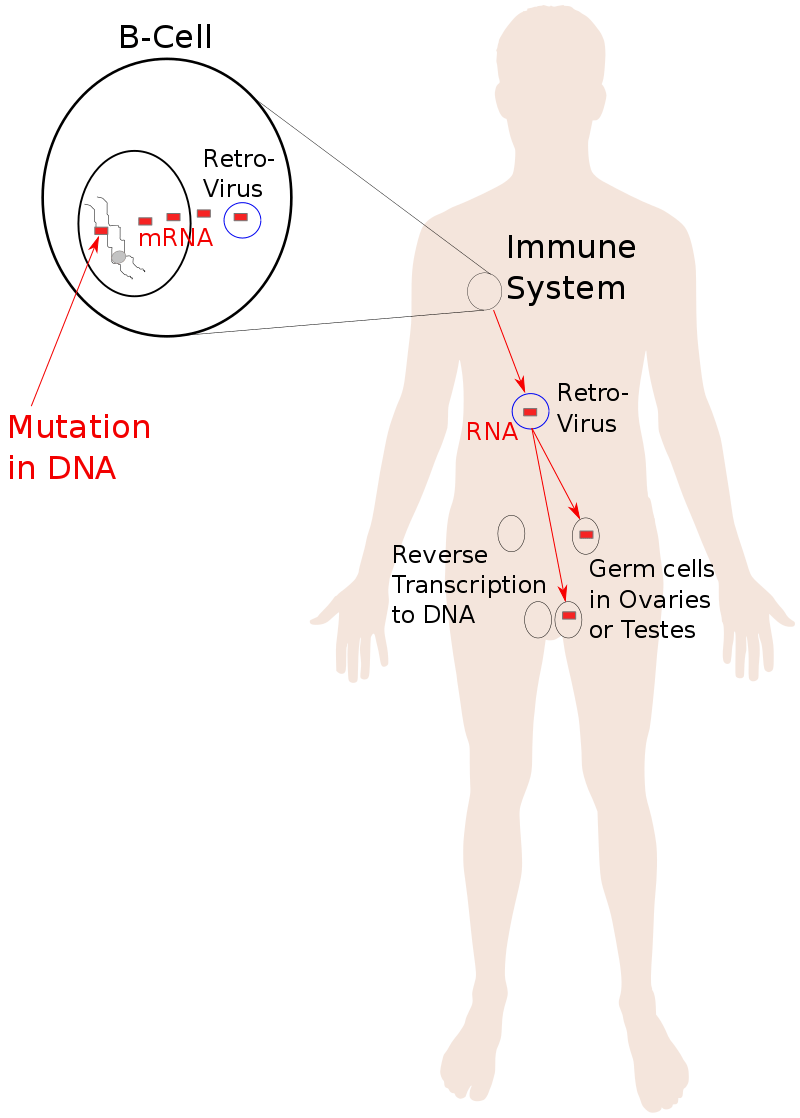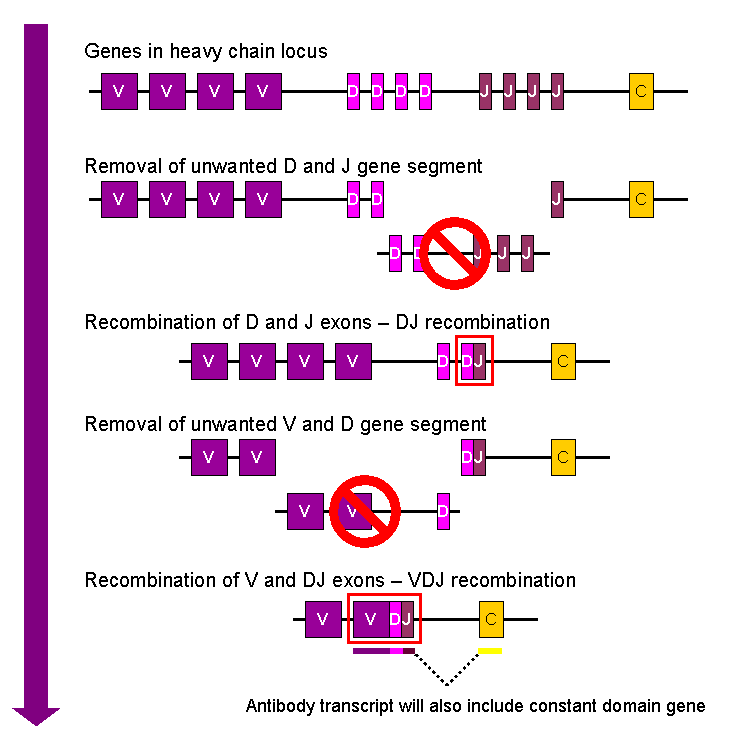What is the Difference Between Somatic Hypermutation and V(D)J Recombination
The key difference between somatic hypermutation and V(D)J recombination is that somatic hypermutation is a process that allows B cells to mutate their genes to produce high-affinity antibodies, while V(D)J recombination is a process of somatic recombination that happens during the lymphocyte development in order to generate highly diverse antibodies and T cells receptors.
Generally, undergo a genetic modification known as somatic hypermutation in the antibody variable region to increase the affinity of antibodies. Immunoglobulins produced from B lymphocytes can recognize almost all kinds of antigens due to their antigen-binding portion known as the variable region. The exons coding for this region is known as V (variable), D (diversity) J (joining). These exons exist as multiple copy arrays on chromosomes. The recombination of V(D)J gene is a genetic modification that acts as the key step to produce diverse antibodies. Moreover, during thymocyte development, T cell receptor chains also undergo the same sequence of recombination events. Hence, somatic hypermutation and V(D)J recombination are two types of genetic modifications that create high-affinity diverse antibodies for foreign antigens.
CONTENTS
1. Overview and Key Difference
2. What is Somatic Hypermutation
3. What is V(D)J Recombination
4. Similarities – Somatic Hypermutation and V(D)J Recombination
5. Somatic Hypermutation vs V(D)J Recombination in Tabular Form
6. Summary
What is Somatic Hypermutation?
Somatic hypermutation is a mechanism that creates mutations in antigen-binding sites of B cells, causing their genes to produce high-affinity antibodies. Antigens trigger somatic hypermutation. Following activation with an antigen, the proliferation of B cells enhances. When B cells proliferate rapidly, the rate of point mutation increases in the genes, encoding for variable domains of the heavy and light chains.

Somatic hypermutation results in one nucleotide change per variable gene in per cell. Therefore, the daughter B cells will acquire slight amino acid differences in the variable domains of their antibody chains. Somatic hypermutation helps to increase the diversity of the antibody pool and impacts the antibody’s antigen binding affinity. Moreover, mistargeted somatic hypermutation is likely caused by the development of B cell lymphomas and many other cancers.
What is V(D)J Recombination?
V(D)J recombination is a process of somatic recombination that results in highly diverse antibodies and T cells receptors and occurs only in developing lymphocytes. Somatic recombination of immunoglobulins is also known as V(D)J recombination and involves the generation of a unique immunoglobulin variable region. The variable region of each immunoglobulin heavy and light chain is encoded in several gene segments (exons). These gene segments are variable (V), diversity (D) and joining (J). V, D, and J segments are found in the heavy chain, but only V and J segments are found in the light chain. Moreover, there are multiple copies of V, D, and J segments that are tandemly arranged in the genome of mammals.

During the recombination process occurring in the bone marrow, a developing B cell selects one V, one D, and one J gene segments randomly and combines them together in order to assemble variable regions of an immunoglobin. Since there are multiple copies of each V, D and J gene segments, the resulting immunoglobins show a great diversity due to the difference in their variable regions. Hence, the antibodies produced by this recombination process have different paratopes and specificity to antigens. T cell receptor chains also undergo the same sequence of recombination during the thymocyte development.
What are the Similarities Between Somatic Hypermutation and V(D)J Recombination?
- Somatic hypermutation and V(D)J recombination are two types of genetic modifications creating high-affinity diverse antibodies for foreign antigens.
- Both processes target the variable region of immunoglobulins.
- They are processes with somatic mechanisms.
- Both processes are highly important for a strong immune system.
What is the Difference Between Somatic Hypermutation and V(D)J Recombination?
Somatic hypermutation is a process that allows B cells to mutate their genes to produce high-affinity antibodies, while V(D)J recombination is a process of somatic recombination that occurs only in developing lymphocytes and results in highly diverse antibodies and T cells receptors. So, this is the key difference between somatic hypermutation and V(D)J recombination. Somatic hypermutation is due to the high rate of point mutations in variable domain genes, while V(D)J recombination is due to the rearrangement of variable domain gene segments.
The following infographic lists the differences between somatic hypermutation and V(D)J recombination in tabular form for side by side comparison.
Summary – Somatic Hypermutation vs V(D)J Recombination
The immune system is essential for our survival. It defends our body against bacteria, viruses, and parasites. Antibodies play an important role in the acquired immune system. Somatic hypermutation and V(D)J recombination are two types of genetic modifications that create high-affinity diverse antibodies for foreign antigens. Somatic hypermutation is a process that allows B cells to mutate their genes to produce high-affinity antibodies, while V(D)J recombination is a process of somatic recombination that occurs only in developing lymphocytes that result in highly diverse antibodies and T cells receptors. Thus, this summarizes the difference between somatic hypermutation and V(D)J recombination.
Reference:
1. “Somatic Hypermutation.” An Overview | ScienceDirect Topics.
2. Chi, Xiying, et al. “V(D)J Recombination, Somatic Hypermutation and Class Switch Recombination of IMMUNOGLOBULINS: Mechanism and Regulation.” Wiley Online Library, John Wiley & Sons, Ltd, 27 Feb. 2020.
Image Courtesy:
1. “Neo-Lamarckian somatic hypermutation and reverse transcription to germline” By Ian Alexander – Own work (CC BY-SA 4.0) via Commons Wikimedia
2. “VDJ recombination” By gustavocarra after en:Ciar – en:Image:VDJ_recombination.png (Public Domain) via Commons Wikimedia
ncG1vNJzZmivp6x7pbXFn5yrnZ6YsqOx07CcnqZemLyue9ahmK1lmah6tbTEZpuinpaav6a6wp5km52krLKmuoyspqaZpJ6wbrTYqZyrpaWprrW1zqdkmqaUYsOltoyrnJynnZe2r63ToqanZw%3D%3D